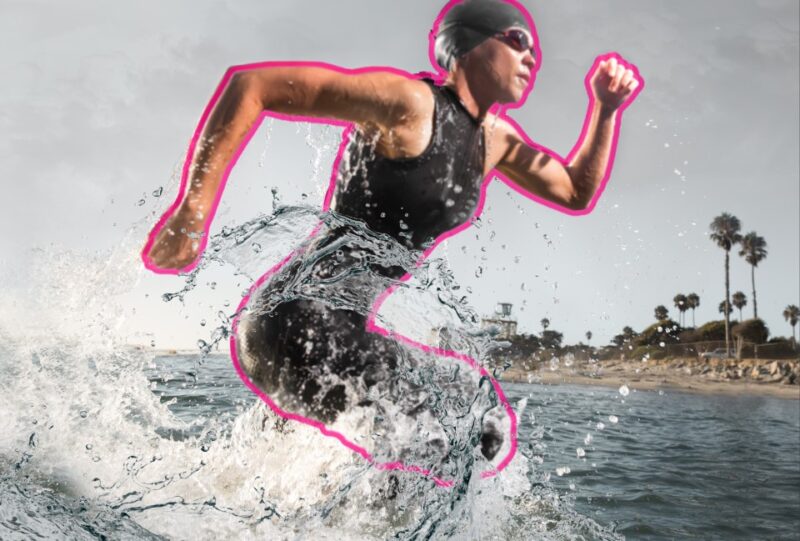I’ve taken on both Ironman and Triathlon races and every time I’m blown away by the intensity and thrill these sports bring. However, for those unfamiliar, the two might seem similar, and some might even consider them interchangeable. Well, let me tell you this is far from the truth.
Although both sports involve swimming, cycling, and running, they are quite different. Today we’ll explore the 7 major differences between an Ironman and a Triathlon and help you gather all the necessary information.
1. Distance
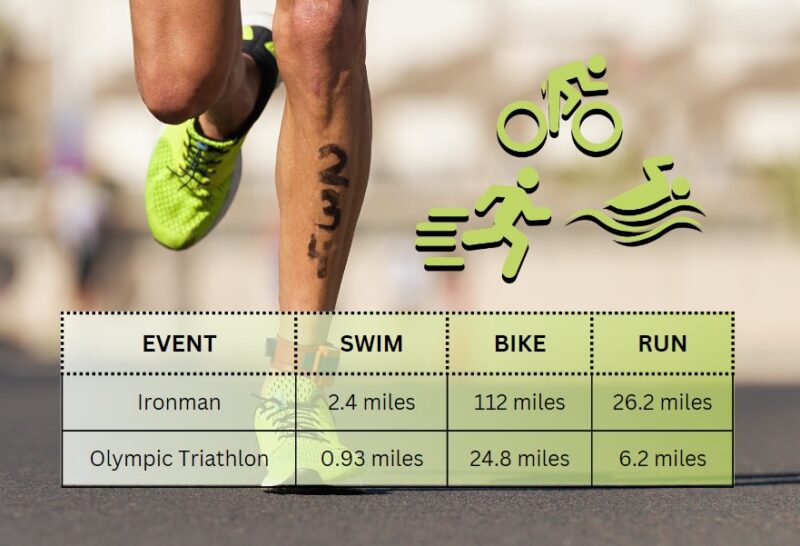
| Event | Swim | Bike | Run |
|---|---|---|---|
| Ironman | 2.4 miles | 112 miles | 26.2 miles |
| Olympic Triathlon | 0.93 miles | 24.8 miles | 6.2 miles |
The distance is the first difference you’ll notice between these two events. An Ironman competition typically involves a 2.4-mile swim, a 112-mile bike ride, and a marathon run of 26.2 miles. This is the standardized layout for every Ironman event worldwide.
Ironman races are famed for their extreme distances and the relentless challenge they pose. Just imagine racing from the crack of dawn until sunset – that’s what most participants have to face. The long-distance nature of Ironman requires specific, intense training and the utmost dedication.
Triathlon, on the other hand, covers a variable range of distances. The most common format is the Olympic distance, which consists of a 0.93-mile swim, a 24.8-mile bike ride, and a 6.2-mile run. Sprint and Super Sprint triathlons are even shorter.
Triathlons offer a variety of distances for all fitness levels. This is one reason why triathlons might be more approachable for beginners. The shorter distances of these races make them a great starting point for athletes looking to venture into multi-sport events.
2. Training and Preparation
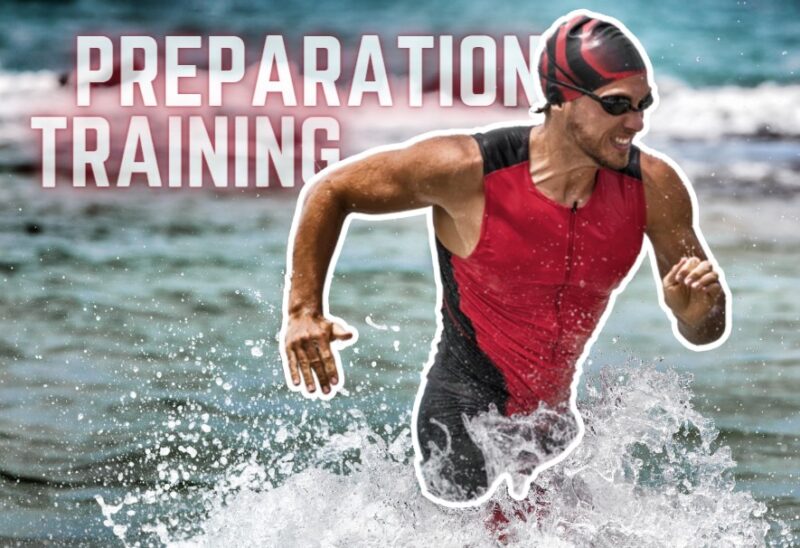
Ironman
Training for an Ironman is an all-consuming task. Athletes typically spend between 12 to 30 hours per week in training, depending on the phase of the training plan. This includes long bike rides, long runs, and long swims, combined with strength training and rest days.
Ironman training requires more than just physical preparation. Athletes also need to focus on their nutrition and mental resilience. Since the race day can last up to 17 hours, it is crucial to maintain energy levels and stay mentally focused.
Triathlon
Training for a Triathlon, while still intense, can be less daunting. Training volume varies depending on the distance of the event but can range from 5 hours per week for sprint distance triathlons to 10-12 hours per week for Olympic distance.
The training, much like the race itself, is more accessible to many people because of the shorter distances and the flexibility it offers. Although intense, it often allows for a better balance between training, work, and personal life compared to Ironman training.
3. Race Duration and Pacing
Ironman
An Ironman event is a test of endurance and perseverance. The average finishing time for an Ironman race is around 12 to 14 hours, but it can stretch up to 17 hours. The pacing for such a long event must be carefully managed.
A common mistake in Ironman is to start too quickly, which can lead to exhaustion later in the race. It’s about understanding your capabilities and managing your energy reserves to last throughout the race. Ironman racing is often described as an exercise in energy management.
Triathlon
In contrast, the shorter distance of a triathlon usually results in faster races. The average finish time for an Olympic distance triathlon is around 3 hours. Therefore, the pacing strategy is quite different. Triathlons demand a more aggressive pace compared to Ironman races.
Athletes often push harder from the beginning, trying to maximize their speed while still conserving enough energy to finish strong. It’s a fine line to walk, requiring both strategy and self-awareness.
4. Equipment and Gear
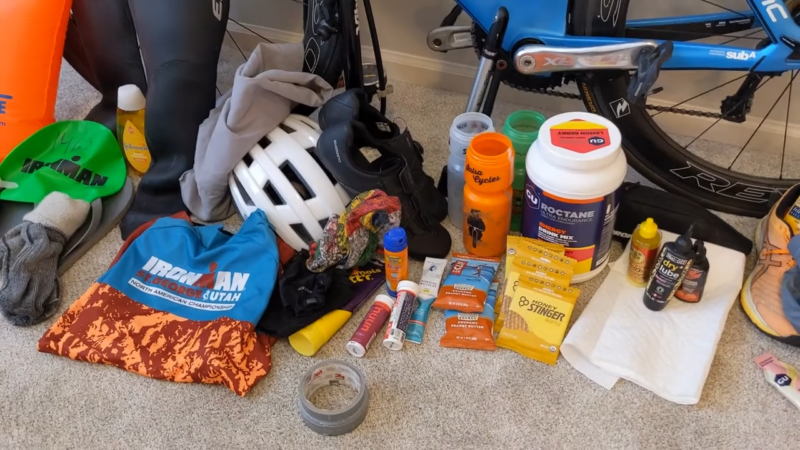
Ironman
Ironman events demand top-tier equipment due to the extreme nature of the race. Athletes often invest in high-performance wetsuits for the swim, aerodynamic bikes for the cycle, and comfortable, breathable clothing for the run.
Nutrition and hydration systems also form an essential part of the gear. An important factor here is reliability – the equipment needs to withstand the duration and intensity of an Ironman race. Any malfunction or discomfort could drastically impact an athlete’s performance and even their ability to finish the race.
Triathlon
Triathlon equipment can be a bit more flexible due to the shorter distances involved. While high-performance gear can provide a competitive edge, it is not as crucial. Many athletes complete triathlons using entry-level gear or even borrowed equipment.
Comfort and convenience often take precedence in triathlon gear choices. Quick transition times are key in triathlons, so athletes often choose gear that can be easily switched. Overall, the gear required for a triathlon can be less costly, making it more accessible to a wider range of athletes.
5. Community and Culture
Ironman
The Ironman community is often described as a tribe. The shared experience of training for and completing such a challenging event creates a strong bond among participants. Ironman athletes are known for their grit, determination, and mutual respect.
There’s a certain prestige that comes with completing an Ironman. It’s more than just a race; it’s a testament to your mental and physical capabilities. The sense of accomplishment that comes with crossing the Ironman finish line is something that binds the Ironman community together.
Triathlon
The triathlon community, while just as supportive, is often more diverse due to the varying race distances. Triathlons attract a wide range of participants, from beginners trying their first race to seasoned athletes aiming for personal records.
This community often focuses on inclusivity and personal growth. Many people start their triathlon journey for the challenge, the fitness, or even the social aspect. It’s a welcoming community that encourages athletes of all skill levels to participate and improve.
6. Recovery time
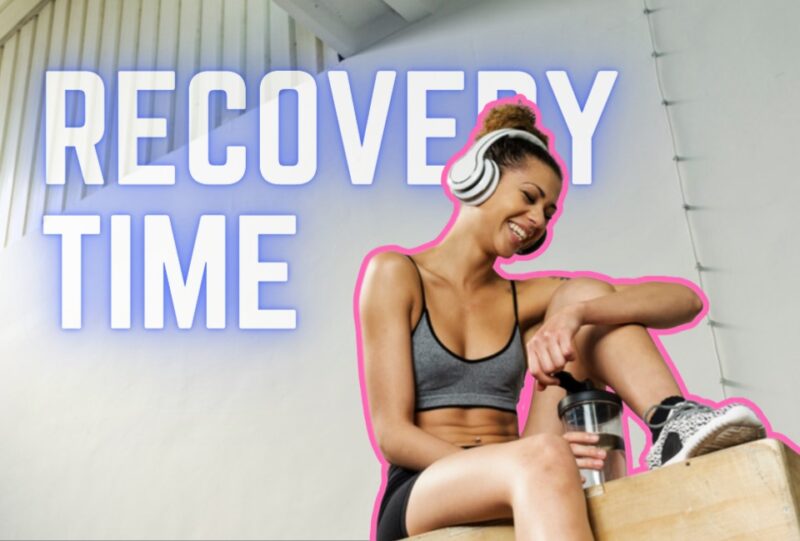
Recovery time after a race, whether it’s an Ironman or a standard triathlon, is a crucial aspect of an athlete’s training and performance. Both events are demanding and put significant strain on the body, so proper recovery is essential to ensure optimal physical and mental health.
| Event | Recovery Time | Key Factors Affecting Recovery | Recommended Recovery Strategies |
|---|---|---|---|
| Ironman Triathlon | 2 to 4 weeks | Fitness level, experience, nutrition, and pacing during the race Post-race blues may occur Muscle soreness and fatigue are significant Individual variations in recovery time Prolonged and intense physical exertion | Focus on active recovery (light swimming, cycling, jogging) Adequate rest and sleep Proper nutrition and hydration Massage therapy, stretching, and foam rolling to alleviate muscle tightness and Gradual return to intense training after the recovery period |
| Standard Triathlon | Varies (typically around 1 week) | Fitness level, experience, nutrition A shorter race distance reduces overall stress on the body Individual variations in recovery time The post-race recovery period is shorter compared to Ironman Adequate rest and sleep | Prioritize rest and relaxation Light activities (short swims, gentle bike rides, light jogs) Proper nutrition and hydration Listen to the body and avoid rushing back into intense training Work with coaches to develop a suitable recovery plan |
Ironman Recovery Time
After completing an Ironman, athletes generally experience significant fatigue and muscle soreness due to prolonged and intense physical exertion. The recovery time can vary depending on several factors, including the athlete’s fitness level, experience, nutrition, and how well they paced themselves during the race.
In the immediate aftermath of the event, athletes may experience post-race blues or a sense of accomplishment, but physical recovery is the primary concern. Typically, it can take anywhere from 2 to 4 weeks for an athlete to fully recover from an Ironman race.
During this time, they may need to take it easy on training and focus on active recovery, such as light swimming, cycling, or jogging. Proper nutrition, hydration, and rest are crucial during the recovery period. Athletes may also benefit from massage therapy, stretching, and foam rolling to alleviate muscle tightness and reduce the risk of injury.
Standard Triathlon Recovery Time
Similar to the Ironman recovery process, athletes should prioritize rest, hydration, and proper nutrition after completing a standard triathlon. Light and easy activities, such as short swims, gentle bike rides, and light jogs, can aid in the recovery process.
It’s important to note that recovery time is not set in stone and can vary significantly from one individual to another. Some athletes may bounce back quicker due to their training background and physical condition, while others may require more time for rest and recuperation.
In both cases, it’s crucial for athletes to listen to their bodies and not rush back into intense training too quickly. Overtraining or not allowing enough recovery time can lead to burnout, decreased performance, and an increased risk of injury.
Triathletes should work with coaches or training professionals to develop a suitable recovery plan that fits their individual needs and supports their long-term athletic goals.
7. Expenses
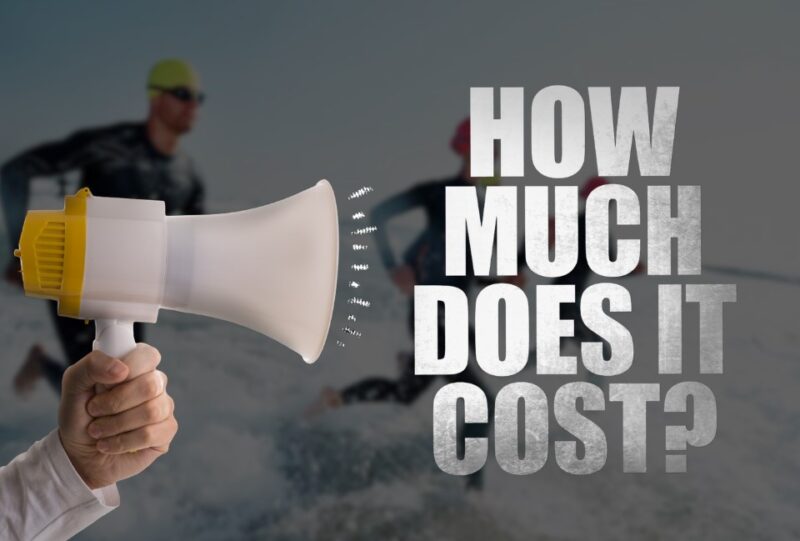
Participating in both Ironman and Triathlon events involves a variety of expenses. These costs can be broadly divided into two categories: entry fees for the race and pre-event expenses.
Entry Fees
The entry fees for these events vary significantly. Since Ironman is a brand owned by the World Triathlon Corporation (WTC), the entry fees for these events are typically higher. Participants can expect to pay around $600-$800 for an Ironman event.
On the other hand, local triathlons, which can be organized by anyone, have lower entry fees. These can start as low as $50, with very elite events being as high as $500.
Pre-Event Expenses
Pre-event expenses primarily include investment in gear and equipment.
| Expense Category | Ironman Cost Range | Triathlon Cost Range |
|---|---|---|
| Entry Fees | $600 – $800 | $50 – $500 |
| Wetsuits | $100 – $500 | $100 – $500 |
| Swim Gear | $20 – $50 | $20 – $50 |
| Bike | $500 – $10,000 | $500 – $10,000 |
| Cycling Gear | $100 – $500 | $100 – $500 |
| Running Shoes | $50 – $200 | $50 – $200 |
| Triathlon Suit | $50 – $300 | $50 – $300 |
| Training Expenses | Varies | Varies |
| Triathlon Licenses | Varies | Varies |
| Travel and Accommodation | Varies | Varies |
What are the benefits of these events?
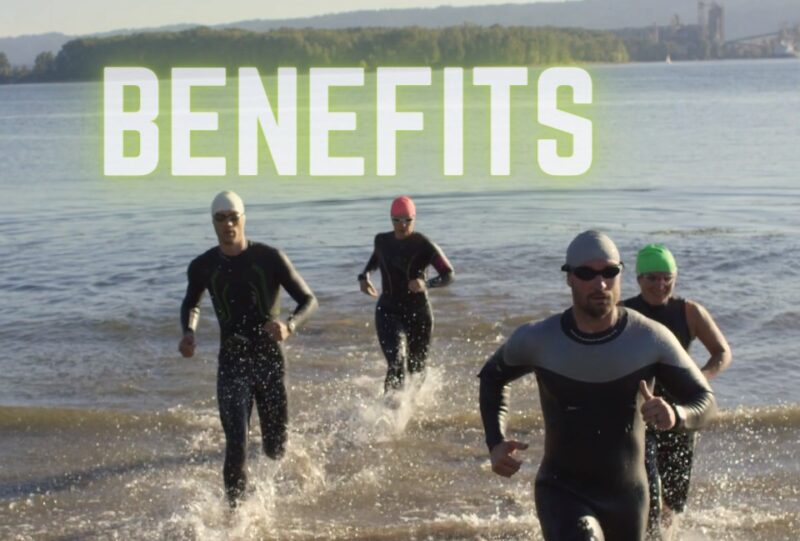
Both Ironman and Triathlon events offer numerous benefits, which can positively impact various aspects of an individual’s physical and mental well-being.
| Benefits | Ironman | Triathlon |
|---|---|---|
| Ultimate Endurance Challenge | ✔️ Pushes athletes to their limits | ✔️ Balanced mix of disciplines |
| Improved Cardiovascular Health | ✔️ Intense cardiovascular training | ✔️ Cardio workout with a variety |
| Enhanced Full-Body Fitness | ✔️ Targets various muscle groups | ✔️ Cross-training benefits |
| Mental Resilience | ✔️ Demands mental toughness | ✔️ Goal setting and achievement |
| Sense of Community | ✔️ Creates a supportive community | ✔️ Opportunities for social engagement |
| Time-Efficient Workouts | ✔️ Complete full-body workout | |
| Weight Management | ✔️ Helps maintain a healthy weight | |
| Stress Relief | ✔️ Releases endorphins |
FAQs:
Can anyone organize a triathlon?
Yes, anyone can organize a triathlon. However, they cannot use the term ‘Ironman’ because it is a brand trademarked and owned by the World Triathlon Corporation (WTC).
What is the difference between an Olympic and a sprint triathlon?
An Olympic triathlon includes a 1.5km swim, a 40km bike ride, and a 10km run. A sprint triathlon usually involves a 750m swim, a 20km bike ride, and a 5km run.
Is an Ironman easier for beginners than a Triathlon?
An Ironman is a tempting activity, but it has a steep learning curve and is not easy at all. A sprint triathlon is a more popular approach to breaking into this multisport world of triathlon.
What is the fastest time to finish a sprint triathlon?
The fastest time to finish a sprint triathlon is 51 minutes and 15 seconds (Mario Mola of Spain).
What is the Ironman 70.3?
A half Ironman, also known as Ironman 70.3 (70.3 being the total number of miles across all three sports), is also a trademark of the World Triathlon Corporation (WTC).
The bottom line
In conclusion, while Ironman and triathlon races both involve the same sports – swimming, cycling, and running – they present significantly different challenges. The choice between an Ironman and a triathlon will ultimately depend on your personal fitness goals, training availability, and your desire for endurance or speed.
Regardless of which path you choose, you will become part of a supportive and determined community of athletes striving to overcome their limits and achieve their personal best.

